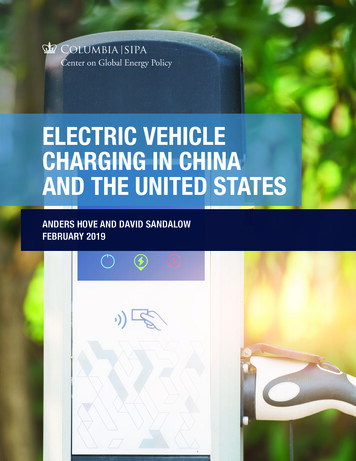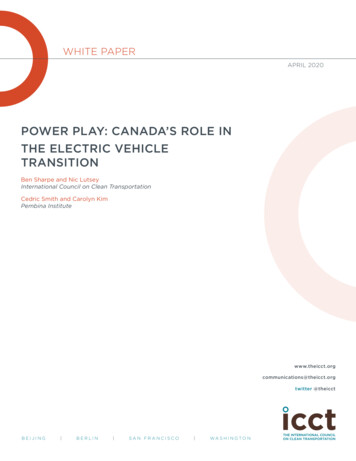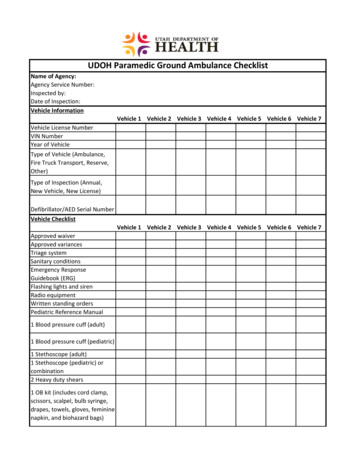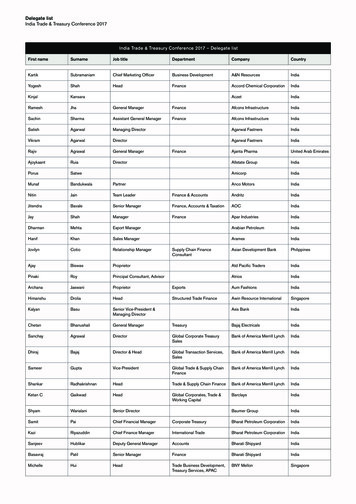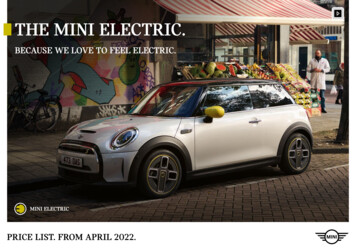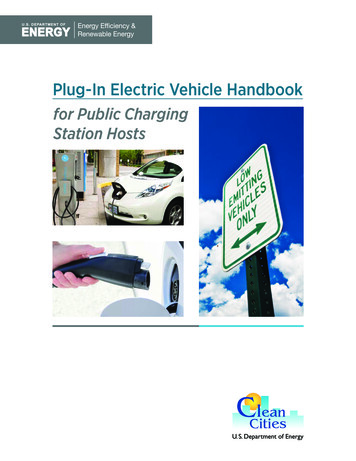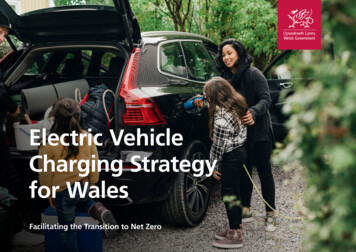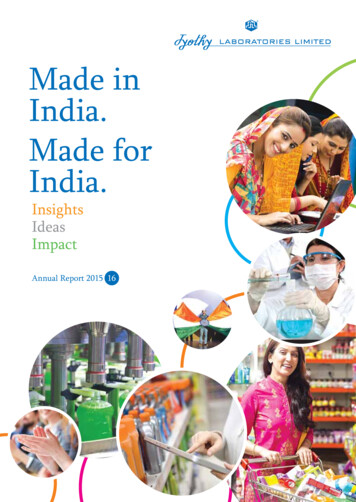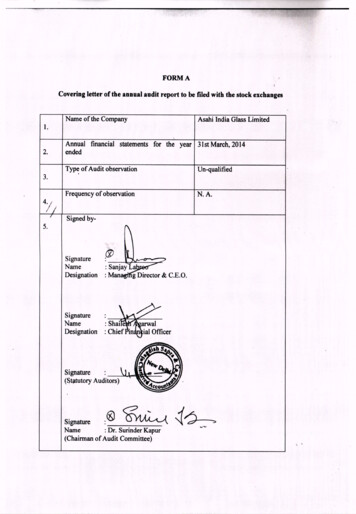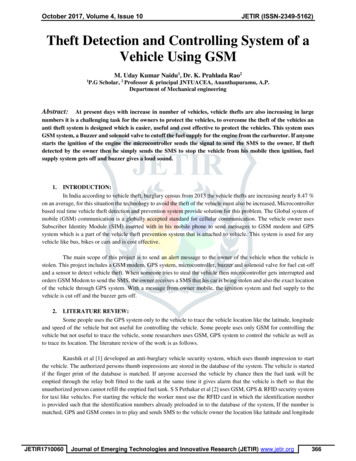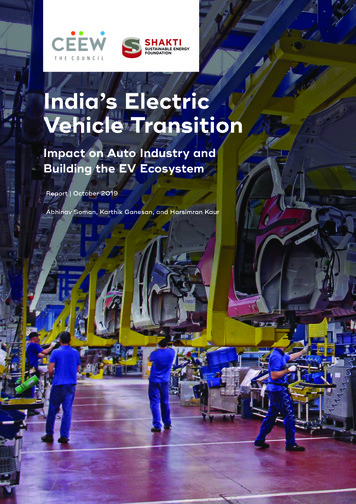
Transcription
India’s ElectricVehicle TransitionImpact on Auto Industry andBuilding the EV EcosystemReport October 2019Abhinav Soman, Karthik Ganesan, and Harsimran Kaur
02India’s Electric Vehicle Transition: Impact on Auto Industry and Building the EV EcosystemThe electric vehicle ecosystem inIndia is in a fledgling state.Image:Imamamg iSgege:SEmotivelenstoctockock
India’s ElectricVehicle TransitionImpact on Auto Industry andBuilding the EV EcosystemAbhinav Soman, Karthik Ganesan, and Harsimran KaurReportOctober 2019ceew.in
Copyright 2019Council on Energy, Environment and Water (CEEW).Open access. Some rights reserved. This report is licenced under the CreativeCommons Attribution- Noncommercial 4.0. International (CC BY-NC 4.0) licence.To view the full licence, visit: www. creativecommons.org/licences/ by-nc/4.0/legalcode.Suggested citation:Soman, Abhinav, Karthik Ganesan, and Harsimran Kaur. 2019. India’s ElectricVehicle Transition: Impact on Auto Industry and Building the EV Ecosystem. NewDelhi: Council on Energy, Environment and Water.Disclaimer:The views expressed in this report are those of the authors and do not necessarilyreflect the views and policies of the Council on Energy, Environment and Water.The views/ analysis expressed in this report also do not necessarily reflect theviews of Shakti Sustainable Energy Foundation. The Foundation also does notguarantee the accuracy of any data included in this publication nor does it acceptany responsibility for the consequences of its use.This publication is for private circulation only.Cover image:iStock.Peer reviewers:Aditya Ramji, Economist, Mahindra and Mahindra; Anup Bandivadekar, ProgramDirector, International Council on Clean Transportation (ICCT), Shikha Rokadiya,Researcher, ICCT; John German, Senior Fellow, ICCT; Sandra Wappelhorst,Researcher, ICCT; Rahul Bagdia, Director, pManifold; and Nikit Abhyankar, SeniorScientific Engineering Associate, Lawrence Berkeley National Laboratory (LBNL).Publication team:Alina Sen (CEEW), Mihir Shah (CEEW), The Clean Copy, Aspire Design, and FriendsDigital.We would like to thank the Shakti Sustainable Energy Foundation for theirsupport on this report.Organisations:The Council on Energy, Environment and Water (ceew.in) is one of SouthAsia’s leading not-for-profit policy research institutions. The Council uses data,integrated analysis, and strategic outreach to explain and change the use, reuse,and misuse of resources. It prides itself on the independence of its high-qualityresearch, develops partnerships with public and private institutions and engageswith the wider public. In 2019, CEEW has once again been featured across ninecategories in the 2018 Global Go To Think Tank Index Report. It has also beenconsistently ranked among the world’s top climate change think tanks. Follow uson Twitter @CEEWIndia for the latest updates.Shakti Sustainable Energy Foundation works to strengthen the energy security ofthe country by aiding the design and implementation of policies that encourageenergy efficiency, renewable energy and sustainable transport solutions, withan emphasis on sub-sectors with the most energy saving potential. Workingtogether with policy makers, civil society, academia, industry and other partners,we take concerted action to help chart out a sustainable energy future for India(www.shaktifoundation.in).Council on Energy, Environment and WaterSanskrit Bhawan, A-10, Qutab Institutional AreaAruna Asaf Ali Marg, New Delhi - 110067, India
iiiAbout CEEWThe Council on Energy, Environment and Water (CEEW) is one of South Asia’s leading not-for-profit policyresearch institutions. The Council uses data, integrated analysis, and strategic outreach to explain – andchange – the use, reuse, and misuse of resources. The Council addresses pressing global challenges throughan integrated and internationally focused approach. It prides itself on the independence of its high-qualityresearch, develops partnerships with public and private institutions, and engages with the wider public.In 2019, CEEW once again featured extensively across nine categories in the 2018 Global Go To ThinkTank Index Report, including being ranked as South Asia’s top think tank (15th globally) with an annualoperating budget of less than USD 5 million for the sixth year in a row. CEEW has also been ranked as SouthAsia’s top energy and resource policy think tank in these rankings. In 2016, CEEW was ranked 2nd in India,4th outside Europe and North America, and 20th globally out of 240 think tanks as per the ICCG ClimateThink Tank’s standardised rankings.In nine years of operations, The Council has engaged in over 230 research projects, published over 160peer-reviewed books, policy reports and papers, advised governments around the world nearly 530 times,engaged with industry to encourage investments in clean technologies and improve efficiency in resourceuse, promoted bilateral and multilateral initiatives between governments on 80 occasions, helped stategovernments with water and irrigation reforms, and organised nearly 300 seminars and conferences.The Council’s major projects on energy policy include India’s largest multidimensional energy accesssurvey (ACCESS); the first independent assessment of India’s solar mission; the Clean Energy AccessNetwork (CLEAN) of hundreds of decentralised clean energy firms; the CEEW Centre for Energy Finance;India’s green industrial policy; the USD 125 million India-U.S. Joint Clean Energy R&D Centers; developingthe strategy for and supporting activities related to the International Solar Alliance; designing the CommonRisk Mitigation Mechanism (CRMM); modelling long-term energy scenarios; energy subsidies reform; energystorage technologies; India’s 2030 Renewable Energy Roadmap; energy efficiency measures for MSMEs;clean energy subsidies (for the Rio 20 Summit); Energy Horizons; clean energy innovations for ruraleconomies; community energy; scaling up rooftop solar; and renewable energy jobs, finance and skills.The Council’s major projects on climate, environment and resource security include advising andcontributing to climate negotiations in Paris (COP-21), especially on the formulating guidelines of the ParisAgreement rule-book; pathways for achieving Nationally Determined Contributions (NDCs) and mid-centurystrategies for decarbonisation; assessing global climate risks; heat-health action plans for Indian cities;assessing India’s adaptation gap; low-carbon rural development; environmental clearances; modelling HFCemissions; the business case for phasing down HFCs; assessing India’s critical minerals; geoengineeringgovernance; climate finance; nuclear power and low-carbon pathways; electric rail transport; monitoringair quality; the business case for energy efficiency and emissions reductions; India’s first report on globalgovernance, submitted to the National Security Adviser; foreign policy implications for resource security;India’s power sector reforms; zero budget natural farming; resource nexus, and strategic industries andtechnologies; and the Maharashtra-Guangdong partnership on sustainability.The Council’s major projects on water governance and security include the 584-page NationalWater Resources Framework Study for India’s 12th Five Year Plan; irrigation reform for Bihar; SwachhBharat; supporting India’s National Water Mission; collective action for water security; mapping India’straditional water bodies; modelling water-energy nexus; circular economy of water; participatory irrigationmanagement in South Asia; domestic water conflicts; modelling decision making at the basin-level;rainwater harvesting; and multi-stakeholder initiatives for urban water management.
vAcknowledgmentsThe authors of this report would like to thank the team at Shakti Sustainable EnergyFoundation for supporting this research on India’s electric mobility ecosystem and its impacton the automotive industry and the economy. This study is of critical importance today givenIndia’s policy agenda to increase the use of electric vehicles.We are grateful to all the stakeholders from the EV industry, charging services, researchinstitutions, and mobility services who particiapted in the interviews and provided us withdetailed information on the EV ecosystem in India today.We thank our reviewers – Aditya Ramji (Mahindra & Mahindra), Anup Bandivadekar(International Council on Clean Transportation (ICCT)), Shikha Rokadiya (ICCT), JohnGerman (ICCT), Sandra Wappelhorst (ICCT), Rahul Bagdia (pManifold), and Nikit Abhyankar(Lawrence Berkely National Laboratory (LBNL)) for their critical feedback and commentsthat have helped in refining this report.We thank our CEEW colleagues, Deepa Janakiraman and Tirtha Biswas, for their help withthe Annual Survey of Industries (ASI) data, which we used to build the analysis on jobs inthe auto industry. We also thank Narayan Gopinathan (former intern with CEEW) for hiscontribution to the assessment of CO2 emissions from cars.Finally, we thank our outreach team, particularly Alina Sen (Communications Specialist),for guiding and supporting us in the publication stage and ensuring that the report meetsCEEW’s quality standards.
viiThe authorsAbhinav SomanKarthik GanesanHarsimran rsimran.kaur@ceew.inAbhinav Soman is a ProgrammeAssociate at The Council. Heresearches the transitionsrequired at three levels to enablesustainable mobility – thetransport sector, urban mobility,and the auto industry. He haspreviously researched behaviouralinterventions that induce modeshift to public transport in theUK. Abhinav holds an MPhilin Engineering for SustainableDevelopment from University ofCambridge and is a Young IndiaFellow 2013–14.An engineer by training, Karthikleads The Council’s work on thepower sector. His research focusincludes the operational reformof discoms in India and thecompetitiveness of various powergeneration sources. He has also leda first-of-its-kind evaluation of theimpact of industrial policies on therenewable energy sector in India.Karthik holds a master’s degree inPublic Policy from the Lee KuanYew School of Public Policy at theNational University of Singapore.He also holds an undergraduatedegree in Civil Engineeringand an MTech in InfrastructureEngineering from the IndianInstitute of Technology, Madras.Harsimran is a Research Analyst atThe Council. Her research focuseson the economic impact of atransition to electric vehicles andpolicy interventions for promotingsustainable mobility. In the past,she has worked on estimatingsubsidies to fossil fuels andanalysing the key policy drivers toaccelerate the adoption of electricvehicles in India. She holds anMTech degree in RenewableEnergy Engineering from TERISchool of Advanced Studies, NewDelhi, and a BTech in Electricaland Electronics Engineering fromGGS Indraprastha University, NewDelhi.“The auto industry is a keystakeholder in India’s transition tosustainable mobility. Whether ornot we should target electric vehiclesales in India, the extent of theirmanufacturing within India, and therate at which we make a transitionto electric mobility are all openquestions today – this report willhopefully assist decision makers intackling these questions.”“As the most dominant contributorto manufacturing, there is littlepublic data available to back howbig the auto sector is, and whatthe impact of a transition couldactually be. We hope this studyprovides that objective assessmentand informs the country’s mobilitytransition.”“As Indian cities vie to becomethe ‘Detroit of electric vehicles’,we find that the auto industrywill stand to gain on many fronts– value add, trade balance, andthe environment. However, beforethat happens, a local supply chainand an EV ecosystem will have tobe in place. This report exploresa range of barriers impeding thedevelopment of an EV ecosystemtoday, and busts misconceptionsregarding the downsides of an EVtransition.”
viiiIndia’s Electric Vehicle Transition: Impact on Auto Industry and Building the EV EcosystemThe EV powertrain consists of fewercomponents than the ICE powertrainImage: iStock
ixContentsExecutive summaryxv1.Introduction1.1 The auto industry landscape1.2 India’s automotive vision1232.Impacts and opportunites for the auto industryin the BAU and EV transition scenarios2.1 Business-as-usual (BAU)2.2 Thirty per cent electric car sales in 20305683.4.Building an EV ecosystem in India3.1 Stakeholders’ comments3.2 Market entry analysisConclusionReferencesDescription of the EV ecosystem andvalue chainAnnexure II: List of formulaeAnnexure III: AssumptionsAnnexure IV: List of Harmonized System (HScodes) and National IndustrialClassification (NIC) codesAnnexure V: Stakeholders in the EV ecosystempresent todayAnnexure VI: Country-wise automotive exportsshare in FY19 (in value terms)Annexure VII: Interviewee list1719252931Annexure I:37444748515253
xIndia’s Electric Vehicle Transition: Impact on Auto Industry and Building the EV EcosystemFiguresFigure 1Car sales have been on the decline since November 20182Figure 2Key automotive exports – cars, 2Ws, and auto components (for cars and 2Ws) – have shown a steadygrowth3Comparison of installed capacity versus production for ICE 4Ws in 2018 and 20305Figure 3Figure 4 Timeline for 100 per cent EV policy implementation in countries that import from IndiaFigure 5The value of car and car auto components exports to countries with 100 per cent EV targets have notbeen exhibiting a steady trendFigure 6 Domestic value added from manufacturing ICE and electric car powertrain (excluding battery)components under both EV30 scenarios will be lesser compared to BAU in 2030Figure 7Domestic value added from manufacturing ICE and electric car in the EV30-High scenario will behigher compared to BAU in 203067910Figure 8 Jobs supported by manufacturing ICE and electric car powertrains will be fewer under the EV30scenarios in 203012Figure 9 The number of jobs in ICE powertrain manufacturing will grow in 2030 even with 30 per centpenetration of electric cars12Figure 10 The import burden of an electric car will be lesser compared to an ICE car in 203014Figure 11 CO2 emissions per kilometre will be lower in an electric car compared to an ICE car in 203015Figure 12 Industries impacted by the core automotive sector15Figure 13 The EV value chain and ecosystem18Figure 14 Lithium and rare earth metal imports to India have increased tremendously between 2010 and 201720Figure 15 Cost reduction levers for bringing down EV costs21Figure 16 Porter’s Five Forces framework25Figure 17 Electric car and 2W models in the Indian market26Figure 18 Purchase price of EVs is higher compared to their ICEV equivalents27Figure 19 Top four 4W OEMs make up 84 per cent of the market share28Figure 20 The cost of powertrain components are lower for EVs than ICEVs37Figure 21 EV battery value chain38TablesTable 1 Electric car penetration scenarios in 20308Table 2 Domestic value added, and additional value add lost to imports of ICE car and electric car powertraincomponents excluding the battery, in 20309Table 3 Domestic value added, and additional value add lost to imports of ICE car and electric car powertraincomponents, including the battery, in 203010Table 4 Comparison of the performance characteristics of an ICE and an electric car26Table 5 ICE car component-wise cost breakup in 2018 and 203047Table 6 Electric car component-wise cost breakup in 2018 and 203047Table 7 Car sales projections for 203047Table 8 List of HS codes considered for the analysis on exports and imports48Table 9 List of NIC codes related to automobile manufacturing50Table 10 Share of output and jobs considered for calculating jobs50
xiAbbreviationsACMAAutomotive Component Manufacturers Association of IndiaAMPAutomotive Mission PlanNAPNational Auto PolicyBEVbattery electric vehicleBNSVAPBharat New Safety Vehicle Assessment ProgramBS-VIBharat Stage VI emission normsDHIDepartment of Heavy IndustryPPPPublic–private partnershipEVelectric vehicleEVSEelectric vehicle supply equipmentFAMEFaster Adoption and Manufacturing of (Hybrid and) Electric VehiclesFYfinancial yearGDPgross domestic productGVAgross value addedHSHarmonized SystemICEVinternal combustion engine vehicleMoHI&PEMinistry of Heavy Industries and Public EnterprisesNATRIPNational Automotive Testing and R&D Infrastructure ProjectNEMMPNational Electric Mobility Mission PlanNICNational Industrial ClassificationOEMoriginal equipment manufacturersSIAMSociety of Indian Automobile ManufacturerSTUstate transport undertakingTCOtotal cost of r
xiiiGlossaryBattery packIt consists of the battery management system (BMS), its mechanicalcomponents, housing, and thermal management and venting unitCommercial vehiclesIt includes motor vehicles that are intended for the carriage ofpassengers more than nine persons (including the driver) or for thetransport of goodsFinancial yearApril 1 to March 31Import burden percarAmount of the crude oil imports (in INR) required for running oneICE car over its lifetimePassenger vehiclesIt includes road motor vehicles, other than motorcycles, intendedfor the carriage of passengers and designed to seat no more thannine persons (including the driver)PowertrainThe mechanism by which power is transmitted to the axle of thevehicle. It includes electric drives, power electronics, and vehicleinterface control modulesValue addIt pertains to market value of goods and services produced by anenterprise. Output value add includes income, value of stock, valueof electricity, value of construction, sale goods, and gross sale valueas per the Annual Survey of Industries (ASI) schedule2WAny two-wheeled vehicle propelled by any type of power otherthan pedalling (including but not restricted to internal combustionengines and electric motors) intended for private use only3WAny three-wheeled vehicle propelled by a motor, generally used forcommercial transport of passengers4WAny four-wheeled vehicle propelled by an internal combustionengine or an electric motor intended for private or commercial use.It includes cars, jeeps, vans, buses, light and heavy commercialvehicles, and trucks
xivIndia’s Electric Vehicle Transition: Impact on Auto Industry and Building the EV EcosystemEVs can address local air pollution,climate change goals and energysecurity concerns for IndiaImage:Imamage:g iStociSStoctockk
xvExecutive summaryThe automotive industry in India is facing headwinds – from a general economicdownturn to the need to improve emissions performance and the impending shift toelectrification. Charting the future course of the auto industry, especially with regard toelectrification, will require an in-depth understanding of the opportunities and impacts thatcan be expected. In this study, we have attempted to assess these by comparing a scenariowith 30 per cent electric car (EV) sales in 2030 against a business-as-usual (BAU) scenariowith limited EV penetration.Beyond 2030, several countries with a significant export share of car and car autocomponents today are targeting 100 per cent EV sales. This may present a lost opportunityfor the Indian auto industry if they are unable to capture the fast-growing global EV marketdue to limited capability and expertise in EV manufacturing.We find that, despite the fewer components needed for producing an electric car, thelocalisation of electric powertrain and battery pack assembly can result in a 5.7 per centhigher output value addition for the auto industry in a 30 per cent electric car salesscenario, when compared to value addition in a BAU scenario in 2030. However, with limitedindigenisation of powertrain and battery pack assembly, there will be an 8 per cent lowervalue addition from an EV transition in 2030.Around 20 to 25 per cent fewer additional car manufacturing jobs will be created in a 30 percent electric car sales scenario, but there will be no job losses as a result of the transition.However, it is critical to ensure that a trained workforce is made available for the new EVmanufacturing jobs that will be created, which would require new and different skill sets.Electric car use can have positive impacts from macroeconomic and environmentalstandpoints. Specifically, the import burden per internal combustion engine (ICE) car will be4.1 times higher for private cars and 5.7 times higher for commercial use cars when comparedto electric cars over their lifetimes, when comparing oil and battery cell imports in 2030.CO2 emissions per electric car will be, in addition, 8 to 24 per cent lower than that of anequivalent ICE car over its lifetime in India.Further, based on consultations with 28 stakeholders from the EV ecosystem in India, wehave identified supply chain, policy, and financing barriers that are impeding the growth ofEVs in India today. Overall, while there is a strong case for transitioning to EVs, as identifiedin this study, a policy package will be needed to address the existing barriers and develop athriving EV ecosystem in India.
xviIndia’s Electric Vehicle Transition: Impact on Auto Industry and Building the EV EcosystemEV manufacturing will require a skilledworkforce which does not exist today.Re-skilling and training of a new workforceis a critical area for EV transition.Imamamage:ge iSStoto ktoc
11. IntroductionIndia is at the cusp of an e-mobility revolution. While it is not a global frontrunner inpromoting and developing an e-mobility ecosystem, a range of compelling reasons makethis paradigm shift in mobility seem inevitable. A transition to electric mobility has thepotential to reduce oil imports, address air pollution in cities, and help meet India’s climatecommitments by reducing the energy intensity of the gross domestic product (GDP). Inaddition, an electric vehicle (EV) transition can spur the growth of new industries andactivities. Further, India’s current competence in auto manufacturing may be threatenedby a global shift towards electric mobility, particularly as the industry aims to becomean internationally competitive manufacturing hub and ramp up its exports. To thoseproviding mobility services, including state transport undertakings (STUs), e-mobility is anopportunity to reduce the total cost of ownership (TCO) and improve financial sustainabilityand profitability. A smooth transition, however, is unlikely without prescient and strategicpolicy interventions and private initiatives to support market development, infrastructuredeployment, and financing.A major uncertainty surrounding the EV transition in India is the impact it would have onthe automotive value chain, particularly on the automotive components industry and thejobs in this sector. The industry has witnessed a continuous decline in sales over the lastyear. While this may point to broader macroeconomic conditions that deter investmentsin vehicles, there is also the added pressure of transitioning to BS-VI and EVs. These arebeing used as possible reasons to explain why consumers are delaying purchase decisionsahead of the roll-out of these new vehicles. Notwithstanding this cyclical downtrend,fewer components are required in an EV powertrain as compared to that of an internalcombustion engine vehicle (ICEV), and this will lead to a loss in value addition in powertrainmanufacturing. Further, in case of limited indigenisation as in the current scenario, mosthigh value addition components in an electric car will have to be imported, resulting in afurther loss in potential value addition from local manufacturing of electric cars.This report explores these scenarios in detail to understand and quantify these impacts andto propose strategies to ensure a transition trajectory that can mitigate any adverse fallout.Further, we also map the current e-mobility ecosystem in India and compile the variouspolicy, finance, and supply chain challenges that the various stakeholders in the ecosystemface today.
India’s Electric Vehicle Transition: Impact on Auto Industry and Building the EV Ecosystem1.1 The auto industry landscapeThe auto industry is a critical driver of macroeconomic growth and technologicaladvancement in India, contributing up to 7.1 per cent to India’s GDP and 5.9 per cent of grossvalue added (GVA) in 2017 (MoHI&PE 2018; PIB 2017). The industry supports 8 million directand 29 million indirect jobs.1 While these numbers are often cited in the media and are evenendorsed by the Government of India and industry publications, there is not much clarity onthe methodology used to arrive at these estimates.India is the world’s largest manufacturer of two-wheelers (2W), three-wheelers (3W), andtractors (MoHI&PE 2018). About 30 million vehicles across various segments were producedin FY19. This represents a growth of 6.3 per cent over the previous year. However, sales acrossall segments have been on the decline since November 2018 (Ghosh 2019). Figure 1 providesa snapshot of the declining sales in the car segment starting November 2018. Additionally,2W account for 80.6 per cent of the total vehicles sold, and passenger vehicles constitutethe next big segment, and represent 12.9 per cent of all domestic sales. Domestic brandshave higher market shares in the commercial vehicles and 2W segments. A total of 46,29,054vehicles were exported in FY19, the lion’s share (70.9 per cent) of which comprised 2Wsfollowed by passenger vehicles (SIAM .-19 ear growth in car sales2-5%-3%Source: Authors’compilation fromTeamBHP. 2019.“Indian Car SalesFigures & Analysis”.-2%-10%-15%-20%Figure 1Car sales have beenon the decline sinceNovember 2018-17%-18%-20%-25%-30%-30%-31%-35%The auto components industry in India has enhanced the localisation of auto componentsfor foreign and Indian original equipment manufacturers (OEMs). It is largely unorganised,comprising 10,000 unorganised players and 700 organised players (Grant Thornton 2018).The sector has grown at a CAGR of 10 per cent from 2012 to 2018. It registered a turnover ofINR 3,45,635 crore (USD 48.1 billion)2 in FY18 (ACMA 2018), and represents about 2.3 per centof the national GDP (Invest India 2019). Exports of auto components added up to INR 90,571crore (USD 12.6 billion) in 2018, while the value of imports amounted to INR 1,06,672 crore(USD 14.8 billion) during the same period (ACMA 2018).3 Auto components exports (for carsand 2Ws) contributed to about 57 per cent of exports of cars and 2Ws and auto components(of cars and 2W) in FY19 (see Figure 2).1Figures provided by Society of Indian Automobile Manufacturers (SIAM).2Exchange rate considered: 1 USD 71.77 INR.3As per our analysis on data from the Export Import Data Bank, the value of exports and imports of autocomponents amounted to INR 61,753 crore (USD 8.6 billion) and INR 57,408 crore (USD 7.9 billion), respectively.Please see the detailed list of Harmonized System (HS) codes we considered to arrive at these values in Table 8in Annexure IV.
Introduction3The performance of the automotive sector as a whole directly impacts the performance ofother related manufacturing sectors such as iron and steel, aluminium, and chemicals, aswell as services including banking, fuels, and logistics. This backward linkage with otherkey contributing sectors of the economy is clear, and the impacts of an EV transition willpercolate both vertically and horizontally.80,000Figure 2Key automotiveexports – cars, 2Ws,and auto components(for cars and 2Ws) –have shown a steadygrowth70,000Exports (INR crore)60,00050,00040,000Source: Ministry ofCommerce & Industry.2019. “Export ImportData Bank”.30,00020,00010,000FY04 FY05 FY06 FY07 FY08 FY09 FY10 FY11 FY12 FY13 FY14 FY15 FY16 FY17 FY18 FY19Cars2WsAuto Components1.2 India’s automotive visionNote: Values in thefigure are in 2019constant prices. Thevalue of exports of autocomponents constitutesonly the major, high-valueauto components, andthe actual numbers areexpected to be higher. SeeTable 8 in Annexure IVfor the detailed list of HScodes.The Automotive Mission Plan (AMP) 2016–26 captures the collective ambition of the Indiangovernment and automotive industry regarding the size of the industry and its contributionto India’s development and its global footprint and competitiveness. The AMP envisions thatthe sector will contribute more than 12 per cent to India’s GDP and constitute more than 40per cent of the manufacturing sector by 2026. Around 65 million direct and indirect jobs areestimated to be created by the auto sector over the next decade. Further, the draft NationalAuto Policy (NAP) envisages India as being among the top three in the world in terms ofengineering, manufacturing, and exporting vehicles and auto components in the comingyears (DHI 2018). The policy prescribes measures such as setting up a technology acquisitionfund and incentivising public–private partnership (PPP) based industry investments inresearch and development (R&D), import duty exemption on auto component prototypes,and support for auto component cluster programmes. India recently overtook Germany tobecome the fourth-largest automobile manufacturer in the world (HDFC 2019).A key area of intervention in order to realise these goals is exports. Extant studies andassessments suggest that the Indian auto industry has the potential to increase its exportsto 35–40 per cent of its overall output by 2026 compared to 28.3 per cent in FY15 (MoHI&PE2017). At the same time, import intensity is slated to increase in the coming years due tothe increased use of electronics and the enhanced design and engineering value adds invehicles and components. These are areas where India is deficient in skills and capabilitiesat the moment. As such, automotive electronics, lightweighting materials, moulds and dies,and machinery are segments of the value chain prioritised by the AMP (MoHI&PE 2017). Atpresent, imports address 60–70 per c
peer-reviewed books, policy reports and papers, advised governments around the world nearly 530 times, engaged with industry to encourage investments in clean technologies and improve effi ciency in resource use, promoted bilateral and multilateral initiatives between governments on 80 occasions, helped state governments with water and irrigation reforms, and organised nearly 300 seminars and .
